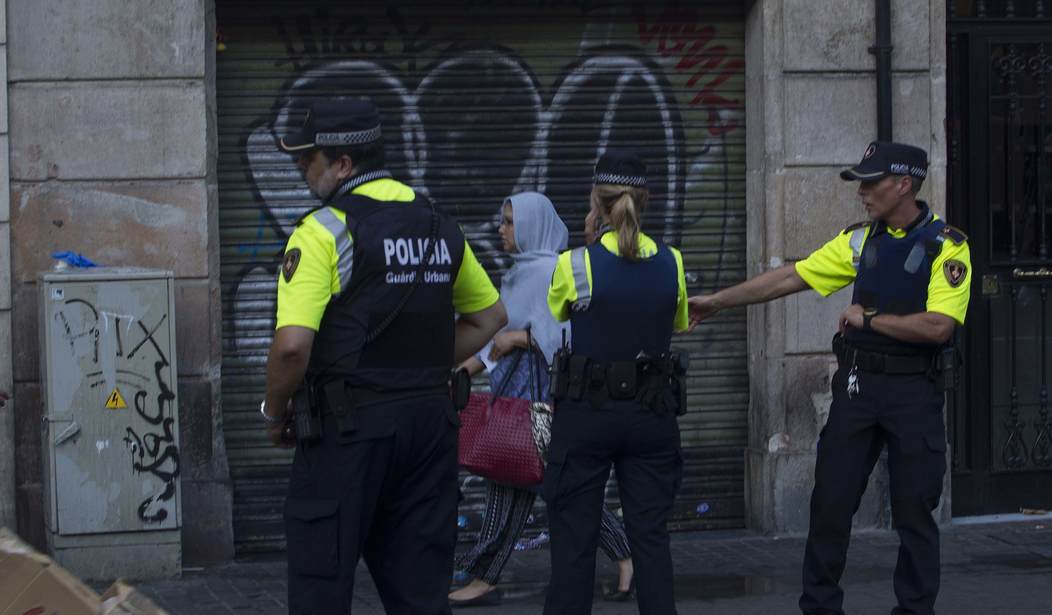Terror attacks this week in Barcelona, Finland, and Russia have European security agencies openly expressing their concerns. And it’s not about “right-wing” terrorism.
Europol chief Robert Wainwright warned on Twitter yesterday that terrorism is the “highest threat in Europe for a generation.”
Terrorism at its most simple and brutal. And highly challenging for police to stop. Highest threat in Europe for a generation @Europol https://t.co/1uLuh6gwG5
— Sir Rob Wainwright (@rwainwright67) August 18, 2017
That warning was in response to Thursday’s car-ramming attack in the popular Las Ramblas tourist area in Barcelona.
So far, 14 people are reported dead from that attack, including American Jared Tucker from California, who was on on his honeymoon.
CA man killed in Barcelona attack was on honeymoon with wife, family says https://t.co/vdF2x3uNOZ pic.twitter.com/jQ9Mr4YyEg
— ABC7 Eyewitness News (@ABC7) August 18, 2017
The Barcelona attack could have been even worse. The terror cell had apparently intended to commit a dual vehicle-borne IED (VBIED) attack, but an explosion Wednesday at the safe house where they were building the bombs forced them to scale back their plans.
Following the Europol chief’s warning yesterday, there was a stabbing terror attack in Turku, Finland, that killed two.
And today, there was an attack in Surgut, Russia, that killed eight.
After initial denials Finnish police say deadly knife attack was terrorism. https://t.co/7arrUb5vMI
— Rita Panahi (@RitaPanahi) August 19, 2017
Islamic State says it carried out the knife attack in Surgut in Russia that injured eight people this morning
— Sky News Breaking (@SkyNewsBreak) August 19, 2017
From 2014 to 2016, jihadist terror attacks in Europe increased from 2 to 30, and the pace of attacks this year is becoming unrelenting.
Map shows how more than 300 innocents have lost their lives in 16 separate jihadist atrocities https://t.co/sfbFtTy5GL pic.twitter.com/9bhmjc15ab
— Daily Mail Online (@MailOnline) August 18, 2017
Jihadist Arrests in EU Doubled Last Year, Rising for Third Year in a Row: Europol https://t.co/xkOSh7Egqo via @pjmedia_com pic.twitter.com/ylwbhP5Px3
— Patrick Poole (@pspoole) June 16, 2017
The number of fatal terrorist attacks in western Europe increased in 2016 https://t.co/jGSM0ckM9a pic.twitter.com/GzyNVfPpUd
— Reuters Graphics (@ReutersGraphics) July 12, 2017
Timeline: Barcelona the latest of major terror attacks across Europe https://t.co/oTd133yriA pic.twitter.com/wcZr1Go6gb
— Irish Examiner (@irishexaminer) August 17, 2017
Now European security officials are describing the escalating terror threat as “the new normal”:
Terror situation in Europe is the 'new normal', says Swedish security boss https://t.co/x5mXZcRqzZ pic.twitter.com/QPK4MmFDQz
— The Local Sweden (@TheLocalSweden) August 18, 2017
Terror attacks are part of living in big city, says Sadiq Khan https://t.co/j9IDbkM5Jb
— The Independent (@Independent) September 22, 2016
#Finland has a nascent ‘jihadist underworld’, security intelligence chief says. Terrorist threat increased.https://t.co/fJA1KuL2MB
— Islamism Map (@IslamismMap) April 18, 2017
#Belgian federal #prosecutor fears an imminent #attack https://t.co/J1SJtDuN2z pic.twitter.com/56u0PLAmBN
— Al Arabiya English (@AlArabiya_Eng) July 6, 2017
The fact is that the scope of the jihadist terror threat in Europe is now entirely unmanageable.
"Germany’s domestic intelligence service estimates there are about 10,000 radical Islamists in the country." https://t.co/ZnKIzGTuf6
— Max Abrahms (@MaxAbrahms) July 28, 2017
Swedish Spy Chief Admits ISIS Sympathizers Have Increased Tenfold to 2,000 https://t.co/8JidsQb3Pp via @pjmedia_com pic.twitter.com/X0Iw6cipyo
— Patrick Poole (@pspoole) July 4, 2017
There are 23,000 jihadist extremists living in Britain as potential terrorist attackers https://t.co/BPK0iSadFa pic.twitter.com/FStaPim0OG
— The Times (@thetimes) May 27, 2017
MI5 figure of 23,000 suspects who pose terrorist threat is probably "the tip of the iceberg" – former intelligence adviser tells #newsnight pic.twitter.com/8rw0LBzf33
— BBC Newsnight (@BBCNewsnight) June 26, 2017
#Catalonia's Islamic extremism problem https://t.co/A5Rvs03Yol pic.twitter.com/vRLYlQ9NVy
— DW News (@dwnews) August 18, 2017
The preferred method of attack in Europe over the past year has been car-ramming, encouraged by ISIS and al-Qaeda:
#NEWSGRAPHIC Fatal vehicle-ramming attacks in Europe since July 2016 @AFP pic.twitter.com/DF9BQMqE3J
— AFP news agency (@AFP) August 18, 2017
Berlin.
Nice.
Stockholm.
London.
And now, #Barcelona.What more can be done to prevent vehicle terror attacks? https://t.co/noMU9wqlsC pic.twitter.com/PhQkNzP3KU
— BBC News (World) (@BBCWorld) August 18, 2017
In an attempt to address the problem, a whole new art form has been developed — “crisis architecture”:
One of my favorite examples of crisis architecture. The Arsenal letters look nice, and they'll stop a car attack. pic.twitter.com/uA5KhCBd2Q
— Daveed Gartenstein-Ross (@DaveedGR) August 17, 2017
And the targeting of popular tourist landmarks is literally changing the face of Europe:
London yesterday: "One must build bridges, not walls"
Londonistan today: "One must build walls on the bridges"
Thank you @MayorofLondon pic.twitter.com/qUfJQZ3EtM— Ashr (@Ashmyr613) June 25, 2017
London: Build bridges not walls.
Also London pic.twitter.com/I86M7IoGx5
— The Self Provisioner – Neil M White (@ThisDadDoes) July 4, 2017
Eiffel Tower will be surrounded by a bulletproof glass wall in a bid to protect the tourist attraction from threats https://t.co/ZWY2g0m0p4 pic.twitter.com/N5zamSZpVN
— The Sunday Times (@thesundaytimes) June 25, 2017
One of the prime targets for jihadist attacks so far this year has been France.
France is the Most-Targeted Nation for Terror Plots in Europe. #Paris https://t.co/1BG7I3rRgO pic.twitter.com/ylCf0Mm6z2
— Nick Short 🇺🇸 (@PoliticalShort) August 9, 2017
If attack on soldiers outside Paris is confirmed to be terrorism, this would be 8th terror event in France this year https://t.co/RRGXrgwWbw
— Patrick Poole (@pspoole) August 9, 2017
#Frannce – The 7 thwarted attacks. (Via @CAT_Centre) pic.twitter.com/2rZPyZb2bX
— Terror Events (@TerrorEvents) July 6, 2017
#France has now upped the # of potential jihadists on its terror watch list to 18,500 from 16,000 6 months ago. Mind boggling Figure.
— Olivier Guitta (@OlivierGuitta) August 6, 2017
As they saw in Paris in 2015 with the Charlie Hebdo and the Bataclan terror attacks, one of the contributing factors to Europe’s terrorism problem is foreign fighters who fought with ISIS and other terror groups in Syria and Iraq:
Hundreds of jihadi militants have returned to France, minister says https://t.co/054Zeoauf7 pic.twitter.com/raE8emcG0o
— Newsweek (@Newsweek) August 7, 2017
France has seen 271 jihadi militants return: minister https://t.co/HPudKcVGLq
— Reuters Iran (@ReutersIran) August 6, 2017
And it’s not just France confronting a problem of returning foreign fighters.
— AFP news agency (@AFP) June 16, 2017
#ISIS Foreign Terrorists arrested in #Turkey are 804 from #Russia,435 #Indonesia,308 #Tajikistan, 278 #Iraq, 254 #France, 252 #Azerbaïdjan. pic.twitter.com/IvchvEqGEV
— Amor Shabbi عمر شابي (@AmorShabbi) July 14, 2017
One approach that France has tried is to hunt them down in Syria and Iraq before they return:
France is ‘hunting down its citizens who joined Isis’ without trial in Iraq https://t.co/6oPH9ydlES
— The Independent (@Independent) May 30, 2017
Other countries are not so proactive in dealing with the returning foreign fighter threat.
Where are the 400 jihadis still in London, @piersmorgan asks @MayorofLondon @SadiqKhan
Full interview: https://t.co/lBg4xY9mJz pic.twitter.com/6lW0hBMh2R
— Good Morning Britain (@GMB) June 6, 2017
As I’ve reported here at PJ Media, U.S. authorities are actively warning their counterparts about the scope of the foreign fighter threat.
New Details on 173-Man Islamic State Terror Team Headed Towards Europe https://t.co/K1D1Cwm1XB via @pjmedia_com
— Patrick Poole (@pspoole) August 1, 2017
BREAKING: U.S. Warns the World About 19,000 ISIS Fighters on the Loose https://t.co/hkQA3UB6R7 via @pjmedia_com
— Patrick Poole (@pspoole) July 30, 2017
How are these terrorist transiting? In many cases, along established refugee routes into Europe.
In both the Barcelona and Turku attacks this week, the terrorists were Moroccan immigrants.
Earlier this month I chronicled the immigration-driven terror problem underway in Germany, which in the lead-up to parliamentary elections is being blamed on Frau Merkel’s open immigration policies.
Germany's Refugee-Driven Terror Problem Out of Control After a Dozen Incidents Since Jan 2016 https://t.co/4r8LtCh3tG via @pjmedia_com
— Patrick Poole (@pspoole) July 31, 2017
Merkel's Refugee Policies Bearing Bitter Fruit https://t.co/hsSnsflxcv #trending
— PJ Media (@PJMedia_com) September 11, 2016
Despite the fact that the U.S. is geographically separated from many of these problems by two vast oceans, we are hardly immune from the threat of jihadist terrorism.
FBI has nearly 1,000 active Islamic State probes inside U.S., cops reveal https://t.co/w9sJ1Pcf9K pic.twitter.com/9itv61x3SM
— The Washington Times (@WashTimes) November 14, 2015
F.B.I. Has ISIS Investigations in All 50 States http://t.co/Nw8azA65Re pic.twitter.com/uz2pDDFM15
— Free Beacon (@FreeBeacon) August 29, 2015
As recent U.S. ISIS-related cases reveal.
U.S. Soldier Ikaika Khan Arrested for Supporting ISIS, Wanted to "Kill a Bunch of People" https://t.co/o2DNJerFH9 via @pjmedia_com
— Patrick Poole (@pspoole) July 11, 2017
Bay Area ISIS Supporter Amer Sinan Alhaggagi Wanted to 'Redefine Terror', Kill 10,000 https://t.co/zPVStilxxp via @pjmedia_com
— Patrick Poole (@pspoole) July 25, 2017
I warned back in April that we may be facing yet another “Summer of Terror,” and the attacks this wee indicate that it may be far from over.
Get Ready For a 'Summer of Terror' https://t.co/A2oYpaYk62 #SummerofTerror via @pjmedia_com
— Patrick Poole (@pspoole) June 6, 2017
Closing Out 2016's 'Summer of Terror': Over the Past 90 Days, 20 Terror Attacks in Western … https://t.co/oIahgh1dKW #homelandsecurity
— PJ Media (@PJMedia_com) October 12, 2016








Join the conversation as a VIP Member